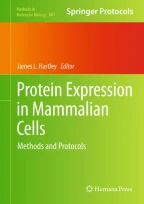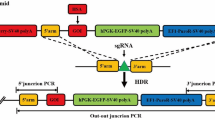Strategies for Efficient Transfection of CHO-Cells with Plasmid DNA

Stable cell lines of Chinese hamster ovary (CHO) cells are the predominant source of commercial biopharmaceutical proteins. Because making suitable CHO cell lines is time-consuming and costly, preliminary experiments with transient expression are usually performed to optimize as many protein production parameters as possible. Here, we describe protocols for optimizing expression in transient expression experiments and isolating stable CHO cell lines using two types of self-made reagents, namely, lipoplexes and polyplexes.
This is a preview of subscription content, log in via an institution to check access.
Access this chapter
Subscribe and save
Springer+ Basic
€32.70 /Month
- Get 10 units per month
- Download Article/Chapter or eBook
- 1 Unit = 1 Article or 1 Chapter
- Cancel anytime
Buy Now
Price includes VAT (France)
eBook EUR 93.08 Price includes VAT (France)
Softcover Book EUR 116.04 Price includes VAT (France)
Hardcover Book EUR 158.24 Price includes VAT (France)
Tax calculation will be finalised at checkout
Purchases are for personal use only

Chapter © 2018

Improved CHO Cell Line Stability and Recombinant Protein Expression During Long-Term Culture
Chapter © 2017

Construction of a CHO cell line with site-specific integration to stably express exogenous proteins using the CRISPR–Cas9 technique
Article 09 November 2022
References
- Crystal, R. (1995) Transfer of genes to humans: early lessons and obstacles to success. Science270, 404–410. ArticlePubMedCASGoogle Scholar
- Tripathy, S., Black, H., Goldwasser, E., and Leiden, J. (1996). Immune responses to transgene-encoded proteins limit the stability of gene expression after injection of replication-defective adenovirus vectors. Nat. Med.2, 545–550. ArticlePubMedCASGoogle Scholar
- Sadelain, M. (2004) Insertional oncogenesis in gene therapy: how much of a risk? Gene Ther.11, 569–573. ArticlePubMedCASGoogle Scholar
- Marshall E. (2002) What to do when clear success comes with an unclear risk? Science298, 510–511. ArticlePubMedCASGoogle Scholar
- Golzio, M., Teissié, J., and Rols, M. (2001) Control by membrane order of voltage-induced permeabilization, loading and gene transfer in mammalian cells. Bioelectrochemistry53, 25–34. ArticlePubMedCASGoogle Scholar
- Golzio, M., Teissie, J., and Rols, M. (2002) Direct visualization at the single-cell level of electrically mediated gene delivery. Proc. Natl. Acad. Sci. USA99, 1292–1297. ArticlePubMedCASGoogle Scholar
- Graham, F. L., and Van der Eb A. J. (1973) A new technique for the assay of infectivity of human adeno-virus 5 DNA. Virology52, 456–467 ArticlePubMedCASGoogle Scholar
- Kim, Y., Park, J., Lee, M., Kim, Y., Park, T., and Kim S. (2005) Polyethylenimine with acid-labile linkages as a biodegradable gene carrier. Journal of Controlled Release103, 209–219. ArticlePubMedCASGoogle Scholar
- Pedraza, C., Bassett, D., McKee, M., Nelea, V., Gbureck, U., and Barralet, J. (2008) The importance of particle size and DNA condensation salt for calcium phosphate nanoparticle transfection. Biomaterials29, 3384–3392. ArticlePubMedCASGoogle Scholar
- Lasic D. D., Templeton N. S. (1996) Liposomes in gene therapy. Advanced Drug Delivery Reviews, 20, 2–3, 221–266 ArticleCASGoogle Scholar
- Lasic, D. (1997) Recent developments in medical applications of liposomes: sterically stabilized liposomes in cancer therapy and gene delivery in vivo. Journal of Controlled Release48, 203–222. ArticleCASGoogle Scholar
- Dufès, C., Uchegbu, I., and Schätzlein, A. (2005) Dendrimers in gene delivery. Adv. Drug. Deliv. Rev.57, 2177–2202. ArticlePubMedGoogle Scholar
- Shcharbin, D., Klajnert, B., and Bryszewska, M. (2009) Dendrimers in gene transfection. Biochemistry (Mosc)74, 1070–1079. ArticleCASGoogle Scholar
- Boussif, O., Lezoualc’h, F. Zanta, M., Mergny, M., Scherman, D., Demeneix, B., and Behr, J. (1995) A versatile vector for gene and oligonucleotide transfer into cells in culture and in vivo: polyethylenimine. Proc. Natl. Acad. Sci. USA92, 7297–7301. ArticlePubMedCASGoogle Scholar
- Lungwitz, U., Breunig, M., Blunk, T., and Göpferich, A. (2005) Polyethylenimine-based non-viral gene delivery systems. Eur. J. Pharm. Biopharm.60, 247–266. ArticlePubMedCASGoogle Scholar
- Breunig, M., Lungwitz, U., Liebl, R., Klar, J. Obermayer, B., Blunk, T., and Goepferich, A. (2007) Mechanistic insights into linear polyethylenimine-mediated gene transfer. Biochim. Biophys. Acta1770, 196–205. ArticlePubMedCASGoogle Scholar
- Kunert, R., Steinfellner, W., Purtscher, M., Assadian A., Katinger, H., (2000) Stable Recombinant Expression of the Anti HIV-1 Monoclonal Antibody 2F5 After IgG3/IgG1 Subclass Switch in CHO Cells. Biotechnology and Bioengineering67 (1): 97–103 ArticlePubMedCASGoogle Scholar
- Gach, JS., Quendler, H., Weik, R., Katinger, H., Kunert, R., (2007) Partial humanisation of an anti-idiotypic antibody against monoclonal antibody 2F5, a potential HIV-1 vaccine? Aids Research and Human Retroviruses; 23 (11), 1405–15 ArticlePubMedCASGoogle Scholar
- Alt, F. W., Kellems, R. E., Bertino, J. R., and Schimke, R. T. (1978) Selective multiplication of dihydrofolate reductase genes in methotrexate-resistant variants of cultured murine cells. J. Biol. Chem.253, 1357–1370. PubMedCASGoogle Scholar
- Urlaub, G., and Chasin, L. A. (1980) Isolation of Chinese hamster cell mutants deficient in dihydrofolate reductase activity. Proc. Natl. Acad. Sci. USA77, 4216–4220. ArticlePubMedCASGoogle Scholar
- Zuidam, N., and Barenholz, Y. (1997) Electrostatic parameters of cationic liposomes commonly used for gene delivery as determined by 4-heptadecyl-7-hydroxycoumarin. Biochim. Biophys. Acta1329, 211–222. ArticlePubMedCASGoogle Scholar
- Simberg, D., Danino, D., Talmon, Y., Minsky, A., Ferrari, M., Wheeler, C., and Barenholz, Y. (2001) Phase behavior, DNA ordering, and size instability of cationic lipoplexes. Relevance to optimal transfection activity. J. Biol. Chem. 276, 47453–47459. CASGoogle Scholar
- D.G. Hunter, D.G. and Frisken, B.J. (1998) Effect of Extrusion Pressure and Lipid Properties on the Size and Polydispersity of Lipid Vesicles. Biophysical Journal, 74, 2996–3002. Google Scholar
- Reisinger, H., Sevcsik, E., Vorauer-Uhl, K., Lohner, K., Katinger, H., and Kunert, R. (2007) Serum-free transfection of CHO-cells with tailor-made unilamellar vesicles. Cytotechnology54, 157–168. ArticlePubMedGoogle Scholar
- Regelin, A. E., Fankhaenel, S., Gurtesch, L., Prinz, C., von Kiedrowski, G., and Massing, U. (2000) Biophysical and lipofection studies of DOTAP analogs. Biochim. Biophys. Acta1464, 151–164. ArticlePubMedCASGoogle Scholar
- Reisinger, H., Steinfellner, W., Katinger, H., and Kunert, R. (2009) Serum-free transfection of CHO cells with chemically defined transfection systems and investigation of their potential for transient and stable transfection. Cytotechnology60, 115–123. ArticlePubMedCASGoogle Scholar
Acknowledgments
We thank Hannes Reisinger for technical help and Marion Tschernutter for her help with manuscript preparation.
Author information
Authors and Affiliations
- Department of Biotechnology, University of Natural Resources and Life Sciences, Vienna, Austria Renate Kunert & Karola Vorauer-Uhl
- Renate Kunert


